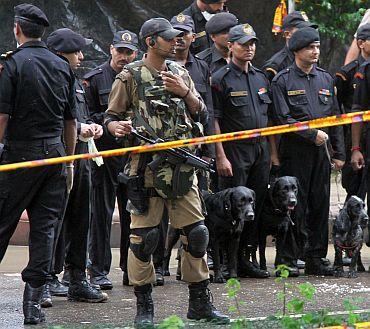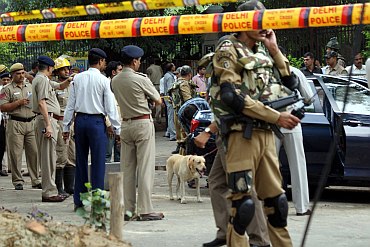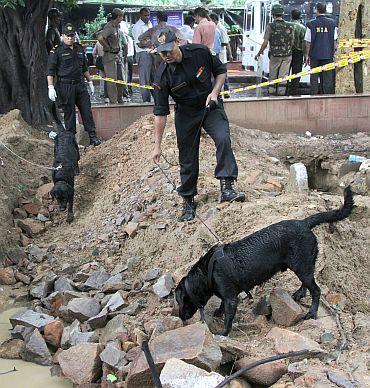 | « Back to article | Print this article |
Delhi police sidelined, NIA to probe Delhi blast
Seemingly unhappy with the Delhi police, the Union home ministry has handed over Wednesday's Delhi high court blast investigations to the National Investigation Agency. This is the first time an investigation of a terror attack has been given to the NIA on the very first day itself.
The move is a huge jolt for the city police force, which is already reeling under its inability to wrap up investigations of many terror attacks, some of which date back to 2005.
Senior officials said that the decision was taken after Home Minister P Chidambaram held a high-level meeting with intelligence officials.
Click NEXT to read further...
Delhi police to 'assist' NIA in investigation
Highly placed sources said that the Delhi police's role in the case would be to 'assist' the NIA in investigating the blast, instead of the other way round, which is usually the case.
"We have been asked to aid and assist the NIA in its investigations. We have collected samples and the NIA have collected their samples independently from the blast site. We will also be conducting parallel investigations as we have probed terror groups successfully in the past," a senior officer of the special cell, part of the anti-terror wing of the Delhi police said.
The general perception for not giving the investigation to the Delhi police is because of the large number of unsolved terror cases in Delhi. The major unsolved terror attack cases include the Diwali bomb blasts (October 2005), Jama Masjid blast (April 2006), Mehrauli blast (September 2008), Jama Masjid firing at tourists and the subsequent car bomb blast (September 2010) and the explosion outside Delhi High Court (May 2011).
Click NEXT to read further...
'Sleeper cells of terror groups carry out attacks independently'
In addition to these, four other low intensity blasts also were reported in south Delhi. These low intensity blasts took place in 2008, the same year in which a serious blast ripped Mehrauli in September 2008, which injured 27 and killed 3, including a 9-year-old.
Investigators believed that the previous low intensity blasts were test runs for the main blasts in Mehrauli and, as is the case in the present high court blast, they failed to prevent that one too.
Special cell sources said that each and every terror attack was thoroughly probed, but they led nowhere because the same signature style of known terror groups were not found in any of the cases. Even though the Indian Mujahideen claimed responsibility for the Jama Masjid terror attack, the police could not really connect it to any of the known operatives of the IM.
"There is a reason that these cases remained unsolved. We have analysed investigation reports of known IM militants on every unsolved terror attack. But as their interrogation revealed, there are several sleeper cells of these outfits active in different cities of India. These cells do not really communicate with the main terror group, but carry out attacks on their own, with some form of assistance from the group," the officer explained.
Click NEXT to read further...
'Intel from home ministry not specific'
In the present case, Chidambaram even claimed that "intelligence pertaining to threat emanating from certain groups was shared with Delhi police in July 2011". Delhi police sources, however, said that the intel was not specific.
"The only instruction we received was that there was a general threat perception and that security needs to be strengthened. The Delhi police was in a state of red alert following the blast that occurred outside the Delhi high court in May. Following the Mumbai blasts, the security was even further strengthened. There is no way a terrorist could have entered the high court complex or any of the busy markets inside Delhi given the present security apparatus in place," a senior police official said.
That really is the strangest part. Delhi has been in a state of red alert following the May 25 blast outside the high court. Even though a special security review conducted by the Delhi police revealed the need for installation of more CCTV at the high court complex, no such installations took place. The installation probably got delayed because of red tape.
The Home Ministry had even warned the Delhi police that the May 25 blasts could be a dry run for further attack at the high court.
When asked about this, the police officer said, "Yes, it is true and we were prepared for it. Following the May 25 blasts, we had sensitised parking lot attendants and other workers outside the high court to maintain vigil for any suspicious looking persons or objects under our Eyes and Ears scheme. Ground sources were deployed and developed. The security in and around New Delhi district area had been beefed up in any case because the Parliament is in session. Police pickets monitored vehicles going in and out of the New Delhi district (Parliament House comes under this district). This explosion took place on the road outside the high court."



